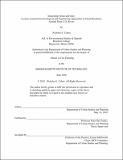Integrating green and gray : lessons learned from ecological and engineering approaches to flood resilience around three U.S. rivers
Author(s)
Cohen, Nicholas E. (Nicholas Evan)
DownloadFull printable version (5.148Mb)
Alternative title
Lessons learned from ecological and engineering approaches to flood resilience around three U.S. rivers
Other Contributors
Massachusetts Institute of Technology. Department of Urban Studies and Planning.
Advisor
Peter Del Tredici.
Terms of use
Metadata
Show full item recordAbstract
There is increased interest in flood resilience around U.S. cities, especially following devastating flooding from recent intense storms. These events have demonstrated challenges associated with both riverine and coastal flooding, involving surface drainage and storm surge. Climate change is anticipated to exacerbate these types of events due to observed and projected sea level rise and increased frequency and intensity of precipitation events. With that context, flood resilience projects are often categorized as either following an engineering approach with hardened, 'gray' infrastructure like berms that seek to keep water out, thus blocking floods, or an ecological approach with soft, 'green' infrastructure around natural systems, like wetlands, that allow water in, absorbing floods and buffering adjacent communities. However, terms such as these, as well resilience itself, often have varying and overlapping definitions in different disciplines. Further, while engineering approaches and ecological approaches may seem at odds with one another, with associated tradeoffs, in reality, projects often integrate elements of both approaches, especially in urban settings. This paper reviews these approaches by comparing case studies around three U.S. urban rivers and understanding the ways ecological and engineering approaches have been integrated into flood resilience projects. Because of the differences between ecological and engineering approaches, this paper first presents a review and comparison of the existing literature on flood resilience and ecological and engineering approaches, along with associated terminologies, utilizing that literature to understand the approaches presented in the case studies. Further, this paper incorporates commentary from existing practitioners involved in these topics and cases to analyze and understand their perspectives. In particular, the paper's focus is on approaches and processes, as project elements most relevant to planners, arguing that the key lessons learned and common features from these projects are the integration of ecological and engineering approaches, collaboration across disciplines, the importance of political and social contexts, the role of non-governmental actors, implementation challenges and strategies, opportunities and limitations presented by reacting to flooding disasters, and sources of funding. Such key common features and lessons learned particularly highlight the critical role of planners in these types of projects.
Description
Thesis: M.C.P., Massachusetts Institute of Technology, Department of Urban Studies and Planning, 2018. This electronic version was submitted by the student author. The certified thesis is available in the Institute Archives and Special Collections. Cataloged from student-submitted PDF version of thesis. Includes bibliographical references (pages 94-100).
Date issued
2018Department
Massachusetts Institute of Technology. Department of Urban Studies and PlanningPublisher
Massachusetts Institute of Technology
Keywords
Urban Studies and Planning.